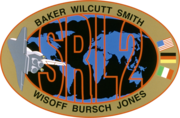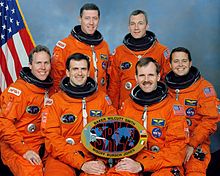STS-68

SRL-2 in Endeavour's payload bay
|
|||||
| Mission type | Radar imaging | ||||
|---|---|---|---|---|---|
| Operator | NASA | ||||
| COSPAR ID | 1994-062A | ||||
| SATCAT № | 23285 | ||||
| Mission duration | 11 days, 05 hours, 46 minutes, 08 seconds | ||||
| Distance travelled | 7,569,092 kilometres (4,703,216 mi) | ||||
| Orbits completed | 182 | ||||
| Spacecraft properties | |||||
| Spacecraft | Space Shuttle Endeavour | ||||
| Crew | |||||
| Crew size | 6 | ||||
| Members |
Michael A. Baker Terrence W. Wilcutt Steven L. Smith Daniel W. Bursch Peter J.K. Wisoff Thomas Jones |
||||
| Start of mission | |||||
| Launch date | 30 September 1994, 11:16:01 UTC | ||||
| Launch site | Kennedy LC-39A | ||||
| End of mission | |||||
| Landing date | 11 October 1994, 17:02:09 UTC | ||||
| Landing site | Edwards Runway 22 | ||||
| Orbital parameters | |||||
| Reference system | Geocentric | ||||
| Regime | Low Earth | ||||
| Perigee | 212 kilometres (132 mi) | ||||
| Apogee | 224 kilometres (139 mi) | ||||
| Inclination | 57.0 degrees | ||||
| Period | 88.85 minutes | ||||
| Epoch | 2 October 1994 | ||||
|
|
|||||


Left to right - Back row: Baker, Wilcutt; Front row: Jones, Wisoff, Smith, Bursch
STS-68 was a human spaceflight mission using Space Shuttle Endeavour that launched from Kennedy Space Center, Florida on 30 September 1994.
Launch 30 September 1994 at 7:16:00.068 am EDT from Kennedy Space Center Launch Pad 39-A. The Launch window opened at 7:16 am EDT with a 2-hour-30-minute window. Orbiter mass at liftoff was 247,129 pounds (112,096 kg) including payload. Total vehicle mass was 2,045,879 kilograms (4,510,391 lb). Payload liftoff mass 12,511 kilograms (27,582 lb). Main Engine Cutoff (MECO) was at an apogee of 115 nautical miles (213 km; 132 mi) and a perigee of 28 nmi (52 km; 32 mi) at MET of 8 min 35 s with Endeavour traveling at 25,779 ft/s (7,857 m/s). No OMS-1 burn was required. OMS-2 burn was 1 min 42 s (164 ft/s or 50 m/s) at MET 33 min.
The launch was originally scheduled 18 August 1994, but there was an RSLS abort at T-1.9 s after all three main engines ignited - the fifth (and final) time in the shuttle program where an RSLS abort occurred after main engine ignition. Previous aborts occurred on STS-41-D, STS-51-F, STS-55 and STS-51. The automatic abort was initiated by the onboard General Purpose Computers (GPC) when the discharge temperature on MPS Main Engine #3 High Pressure Oxidizer Turbopump (HPOT) exceeded its redline value. The HPOT typically operates at 28,120 rpm and boosts the liquid oxygen pressure from 422 to 4,300 psi (2.91 to 29.6 MPa). There are 2 sensor channels measuring temperature on the HPOT. The B channel indicated a redline condition while the other was near redline conditions. The temperature at shutdown was at 1563 degrees Rankine (868 K), while a normal HPOT discharge temperature is around 1,403 °R (779 K). The redline limit to initiate a shutdown is at 867 K. This limit increases to 980 K at T−1.3 s (5.3 s after Main Engine Start). Main Engine #3 (SN 2032) has been used on two previous flights with 2,412 seconds (40 min) of hot-fire time and a total of eight starts. This was the first flight for the HPOT on Main Engine (SSME) #3.
...
Wikipedia
